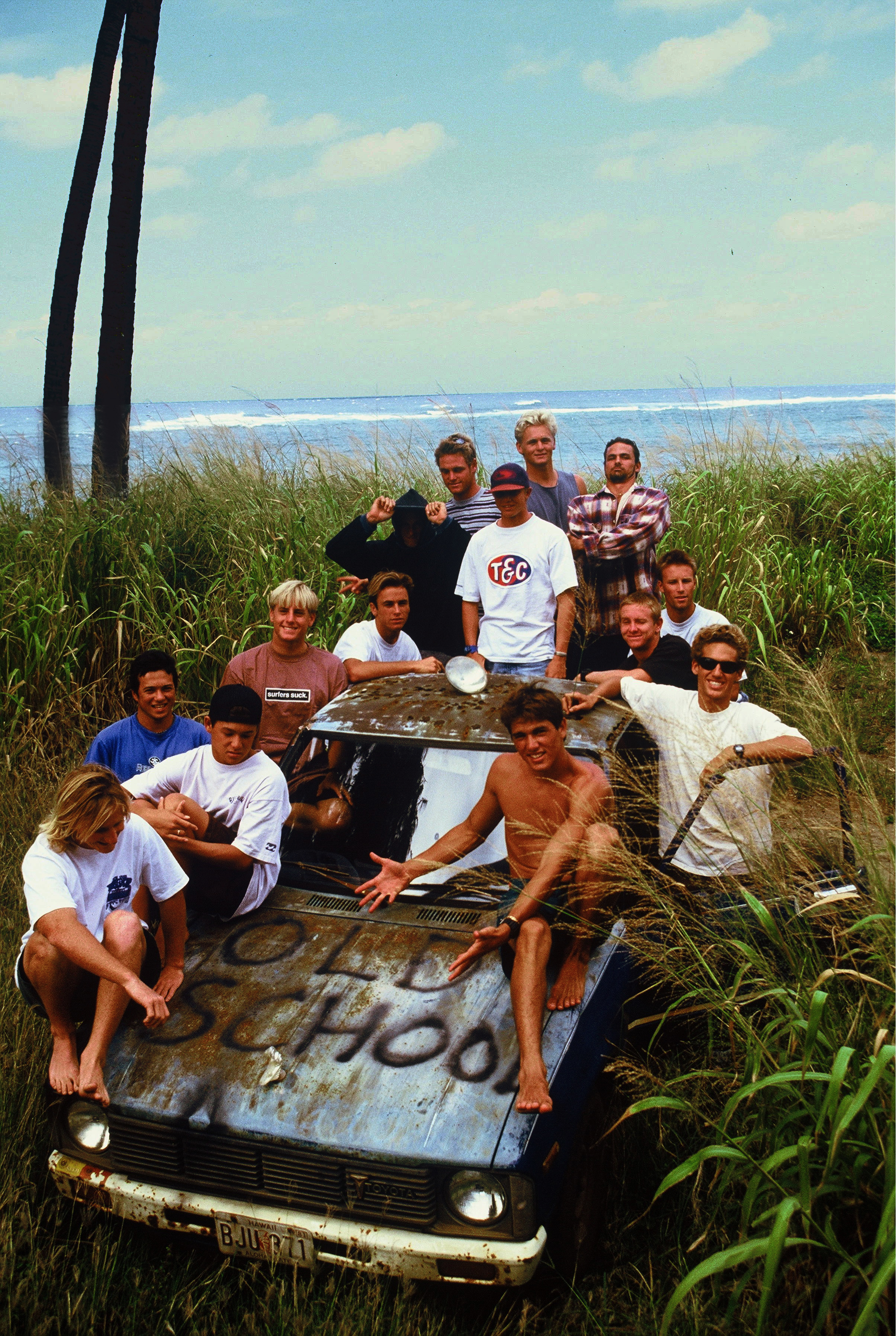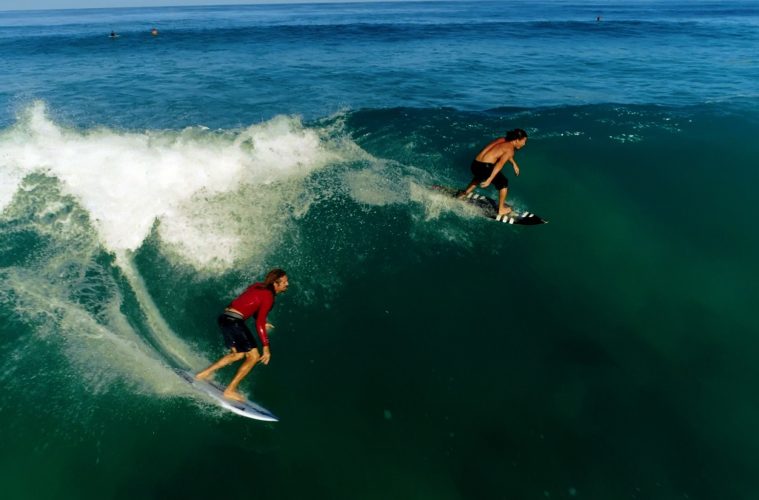If you’re looking for a fantastic piece of storytelling, check out “Momentum Generation,” which premieres December 11 on HBO Sports. This riveting surfing film takes an in depth look at a group of legendary surfers, who forever energized the sport and its competitive culture in the 1990s.
Executive produced by Robert Redford, the documentary shows the close-knit bond that top athletes Kelly Slater, Rob Machado, Shane Dorian, Taylor Knox, Benji Weatherley, Kalani Robb, Ross Williams, Pat O’Connell and surfing filmmaker, Taylor Steele, formed, back when they were punk-rock-loving teens surfing in Hawaii, living under the same roof.

LOS ANGELES, CA – NOVEMBER 05: (L-R) Bill Simmons, Peter Nelson, Casey Bloys, Richard Plepler, Kalani Robb, Kelly Slater and Max Kellerman arrive at the Los Angeles Premiere Of Momentum Generation From HBO on November 5, 2018 in Los Angeles, California. (Photo by FilmMagic/FilmMagic for HBO)
Many of these pro surfers came from broken, neglected homes and were searching for a sense of community that was missing from their lives. Propelled by their close friendship, the group became known as the “Momentum Generation,” winning world titles and breaking records while being featured in Steele’s iconic surfing films.
Irvine Weekly talked exclusively to Knox, Steele and O’Connell about this riveting documentary and O.C. surf culture.
Irvine Weekly: We get a real bird’s eye view of surf culture in the 1990s. How has it changed?
Taylor Knox: Surf culture is different in a lot of ways and the same in a lot of ways. The sport itself has grown so much in a more professional manner when it comes to contests and surfers training and being focused at a really early age.
Twelve-year-old kids are just ripping and doing stuff that 30 years ago, would’ve never been thought possible! And it’s still the same, in the fact that when you are surfing for fun, it is truly a unique art. So much of your style is a representation of your personality.
I feel like, on a progressive level, the sport is moving at a breakneck speed. But there is still a large population of surfers that really enjoy just getting in the powerful thing called the ocean.
Pat O’Connell: Surf culture hasn’t changed much really. The idea of getting in the water, riding a few waves as a way of exercise, social stimulation and a mental reset are the same today as they have been for a long time. What seems different today is the broad group of people who are surfing on a regular basis.
Taylor Steele: The surf culture has always been about enjoying the moment and having fun. From the early ‘90s when I started until now, it’s been the same. The only difference is how people perceive surfers. In the ‘80s, surfers were viewed as losers and drop-outs. Sort of like Jeff Spicoli from “Fast Times at Ridgemont High.”
Now surfers are almost viewed as “evolved” since they live in the moment. Plus, surfers are everything from doctors and politicians to kids surfing with their grandparents.
IW: How did the documentary come about?
Steele: One of the producers, Justine Chiara, knew Rob Machado and Kelly Slater and felt their story was inspiring. As she formed the filmmaking team, they dug deeper into the story and realized that a group of friends working together was the secret to our success.

Photo by Mike Balze
IW: As a group who have known each other for decades, and experienced the highs and lows of friendship, what was it like to watch this film and see yourselves onscreen?
O’Connell: Funny, one of the big takeaways for me was I felt like I had time traveled back to the ’90s. It was crazy to see and feel. The stories and images brought me back. Honestly, the team did such a good job rebuilding that time of our lives. Some of it was hard to see, some makes you smile but it was pretty real and honest.
Steele: It was really surreal to watch it. I cried, laughed and was transported back in time. It was nice to see someone else’s view of our group of friends. I donated all my footage, which was about 4,000 hours of raw footage. I don’t even know what is on most of the tapes. Then I did an eight-hour interview.
Knox: Watching it for the first time was emotional … really every time has been emotional. It was a big part of our lives and in how we turned out as we grew up in a fast way. We were lucky to have people like Todd Chesser (a surfer who was killed navigating huge waves) and (pro surfer) Brock Little to guide us the right way.
It was definitely the longest interview I have ever done though (nine hours), but they had a lot of back stories that I didn’t think they would have, which was good.
IW: Why do you think you guys became so close growing up?
O’Connell: Very good question. It’s a special group. We all had similar goals, ideas about what we wanted to do and what was needed to get there. The passion for surfing was a huge part of that bond. We all had different family backgrounds, some good and others not but that stuff never really came out until much later. We all just loved to surf together and have fun as any other kids would. We just had a more talented crew.
Steele: We all had the same desire to have a career in the surf world. We were all each other’s family on the road for nine months out of the year. We are all still very close.
Knox: I think we were all finding our way in life and at the same time changing the sport. It was all happening so fast. It really helped to have those friendships to keep us on track.
IW: Tell us about your memories hanging out in Irvine/Orange County.
O’Connell: I have a million memories. Every summer this same crew would stay at my parents’ house in Dana Point. We’d all go and surf, hang at the house and enjoy summers together. We would compete together, stay together and travel together. They were really good times. Very simple: surf, sleep and surf more … and sometimes chase girls.
Knox: I grew up going to watch contests in Huntington Beach and then probably did a couple hundred contests in Orange County. It seems like I was up there every other weekend. There is a large concentration of surf industry there, maybe the most of anywhere. Each country has an area where a lot of the surf companies congregate and that seems to be the spot in the U.S.

Photo Courtesy of HBO
IW: Mr. Steele, you created surf films with punk music, which were shown in O.C.
Steele: We had some crazy premieres in Irvine with (punk bands) Pennywise and Sprung Monkey that were 2,000 people large. A massive mosh pit sticks out. Besides that, many surf sessions were in Newport and Huntington Beach. Growing up in San Diego, it’s a quick trip up the coast to go surf or hang out in that area. Nothing but good times there.
IW: Are you working with any surf brands in O.C.?
Knox: I am working with a couple companies in Orange County right now. On A Mission sponsors me for traction pads, leashes and board bags. I’ve been with them for over 20 years, which is super cool, considering it’s rare to be with a company that long. I also just got a new sponsor – the Murf Electric Bike company in San Clemente. Having one of those is kinda a game charger!
O’Connell: I work for Hurley, based out of Costa Mesa. I manage our sports marketing department, working with up-and-coming athletes. Orange County is definitely one of the top places in the U.S. to surf. Surf culture is strong here, with a ton of brands and great waves. The industry has grown a lot since we were kids. The modern-day surfboard was created in Dana Point. There are a ton of surf spots in Huntington Beach, plus Quiksilver is in Huntington Beach, and Volcom is in Costa Mesa. It’s a place we all like returning to.
Steele: I have a lot of friends who run some of the biggest surf brands today. Those are all based out of Orange County. Like Billabong and Hurley.
Advertising disclosure: We may receive compensation for some of the links in our stories. Thank you for supporting Irvine Weekly and our advertisers.

